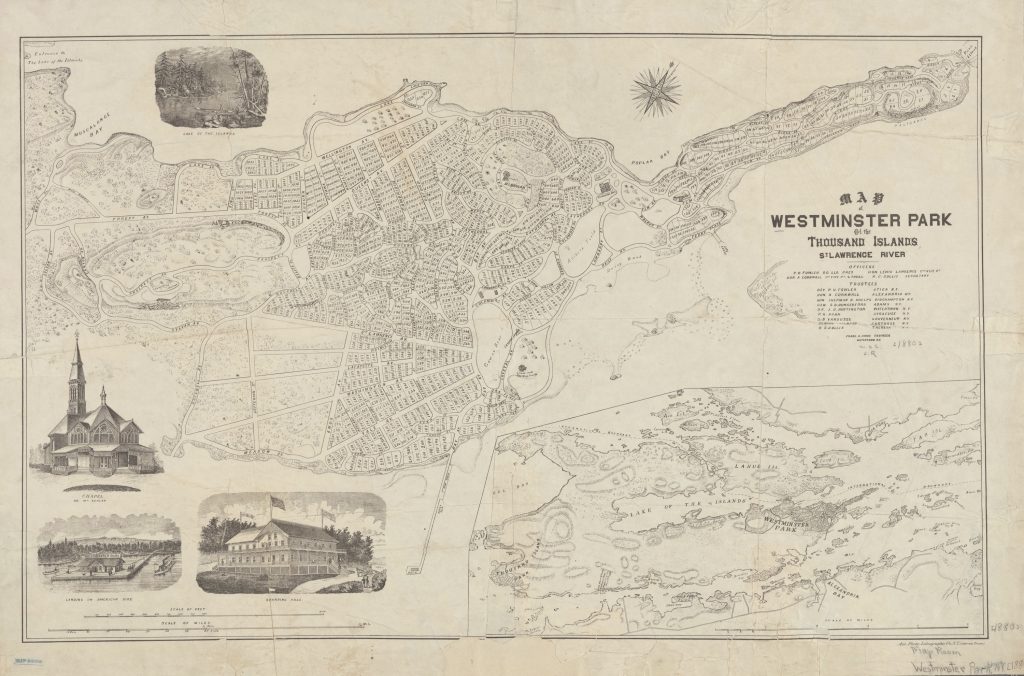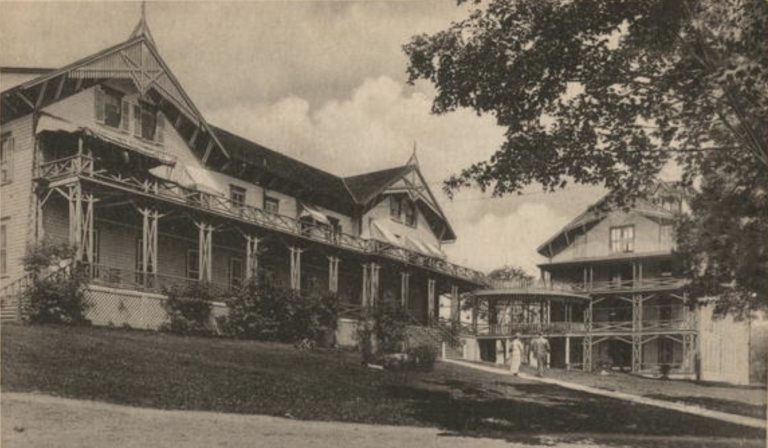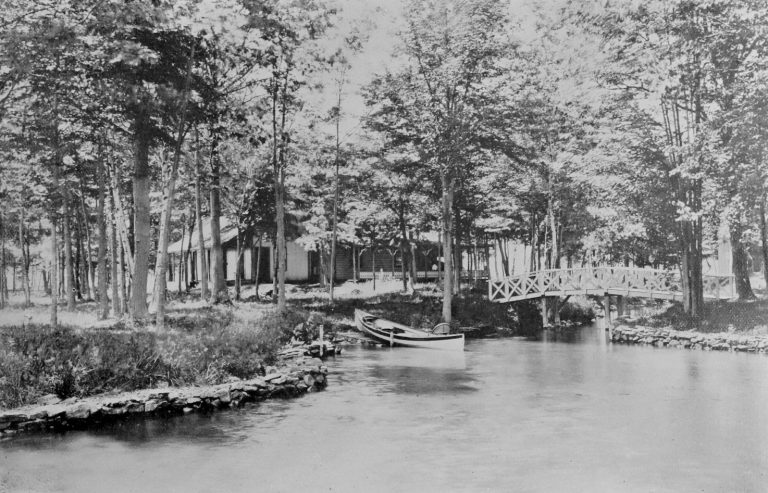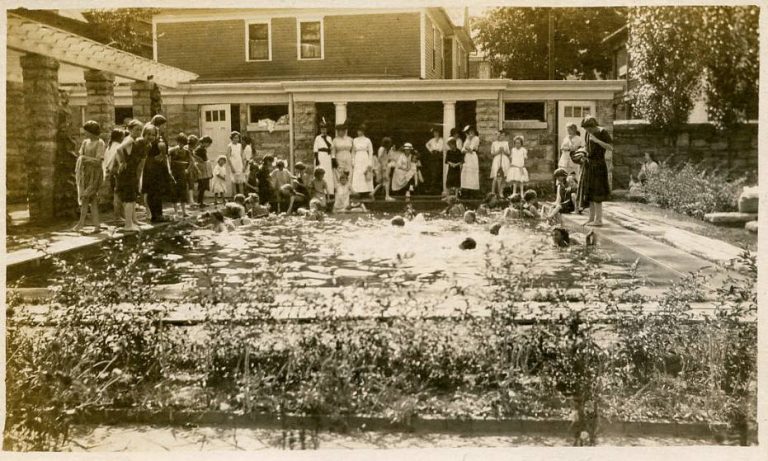Westminster Park – Est. 1877 On “Wells Island”
In 1877, an association was formed to purchase land on the eastern end of Wellesley Island in what would become Westminster Park. The Watertown Daily Times reported in April of that year the proposed purchase was to make the park of approximately 500 acres “a popular place of resort for summer meetings of a religious character, Sunday school conventions, social picnics, etc.” The Thousand Island Park, on the opposite end of what was then known as “Wells Island,” was established two years prior as a Methodist summer community, whereas Westminster was founded by Presbyterians.

The land eyed for Westminster Park had been part of the Walton Estate going back to at least the early 1800s until 1858, when descendants sold it to Captain Horatio Nelson Throop, of Pultneyville, Wayne County, who owned it at the time of the sale in 1877 to the Presbyterian Company.
Throop was actively involved with the underground railroad and operated the steamboat Ontario which he used to transport fugitive slaves amongst other cargo from places like Rochester and his hometown, located about 20 miles eastward on the shores of Lake Ontario, to Canada.

The corporators, as they were referred to, who organized the park included Andrew Cornwall, of Alexandria Bay; General Solon D. Hungerford, of Adams; Dr. John D. Huntington of Watertown; Rosell C. Collis of Theresa; George Gilbert, of Carthage, and Stephen B. Van Duzee, of Gouverneur. The first Trustees were the persons above named, together with Patrick H. Agan, of Syracuse, Lewis Lawrence, of Utica, and Rev. Philemon H. Fowler, of Utica.
Note: the above information came from the book, The Thousand Islands of the River St. Lawrence, edited by Franklin B. Hough and published in 1880. There is an article from 1940 in the Watertown Daily Times that contradicts this, stating new articles were filed in 1887 and the people listed above were then added, which appears to be incorrect (e.g. Philemon H. Fowler passed away in 1879, and the book, as noted, was published a year later.)

“The Wanderer,” aka Captain Visgar, wrote in Meanderings Among a Thousand Islands, published in 1882–
The organization was formerly effected and land purchased in September, 1877, and during the fall of that year work was commenced in clearing and opening avenues through the dense forest growth which covered a large part of the grounds. Lots were laid out and a considerable number sold in the spring of 1878, at which time a hotel was erected and the park opened for public use.
Some fine cottages and residences have been built, with which the Park House, generally accommodate a population of several hundreds during the summer months. This year several cottages have been built or are in course of construction on prominent points, some of which are large and expensive.

The Westminster Bethune Chapel On Mount Beulah
In the March 18, 1878 edition of the Utica Morning Herald, it was announced that plans for the Westminster Park Chapel had been completed–
The plans of Architect W. H. Hamilton, of the Parker Block, Utica, for the chapel to be erected in Westminster Park, on the St. Lawrence River, have been accepted and approved. They provide for a magnificent Gothic chapel to be erected at a cost of $8,500, which will have the appearance of a structure that could easily be made to cost $100,000 in any city.
The chapel when completed will be one of the most noticeable structures upon the magnificent river. The auditorium will be of hexagon form and the transept in octagon, the seats being arranged in amphitheater style so that each will command a view of the pulpit.
The chapel will have five sides which can be raised like a sash, allowing the occupants of the auditorium to have access to the broad piazza which surrounds it. The main auditorium will be fifty feet in height and will seat 366 persons, while the piazza will accommodate 600 additional. The piazza will be protected by curtains which will exclude the sun and wind.

The Westminster Chapel was named Bethune Chapel and dedicated on July 31, 1878, with Rev. Philemon H. Fowler officiating. Several years later, the chapel’s tower, a distinguished landmark that could be seen for miles, was badly damaged from a severe wind storm during the winter of 1885. Four years prior to this, there was discussion of building a new chapel due to complaints of the hike up Mount Beulah to attend service.
The Bethune Chapel continued to be used up until 1885, but no further information could be found after the complete inspection of the park was performed in May of 1885 when the damaged chapel tower was noted in the newspapers. It apparently wasn’t used afterward and considered destroyed as services were held in the Westminster Park Hotel parlors until 1892 when the new chapel was dedicated on July 17, 1892 – conveniently located next to the hotel.

The Westminster Park Hotel
Also part of the Westminster Park master plan was the hotel which was constructed concurrently with the Bethune Chapel. The hotel was completed in 1878 and run by a man with the last name of Steele from Adams, N.Y., but an annex with an additional 50 rooms was added later and the management changed to the Harrington Brothers. After their tenure, it was managed by former Watertown mayor Hiram F. Inglehart who was succeeded by his sons, Chester and H. Fred, as it remained in the Inglehart family for 45 years.
During those years, the Westminster Park Hotel became a place of employment for a number of younger individuals who would become well-known. The Watertown Daily Times on September 5, 1940 explained–
In the summer of 1889, early in the ownership of Mayor Inglehart, Senator George H. Cobb, then a young law student, became clerk at the hotel. After two years Mr. Cobb was made manager of the hostelry.
It was in the summer of 1890, a year after Mr. Cobb went to Westminster as clerk, that the late Delos M. Cosgrove, who was later to become his law partner, came to the hotel as a waiter. He was a young man getting an education then.
At the same time Mr. Cosgrove was there as a waiter, Dr. M. M. Ryan of Redwood and Arthur E. Sherwood, then of Copenhagen, were also waiters.

In 1927, H. Fred Inglehart disposed of the property to Major Kinsley W. Slauson, who formed the Wells Island Hotel & Realty Corporation (the two would later battle over Slauson’s attempting selling of stakes of stock shares Inglehart took as partial payment to Edward J. Noble and George C. Boldt, Jr. while stationed in France shortly after the purchase was made.)
With the Great Depression, existing financing, and being stationed abroad, Major Slauson was unable to make a success of the venture and it went bankrupt, though he did bid for the property and remaining assets of the association’s holdings in 1938, which included 60 acres.
The $3,300 bid won and Slauson planned a redevelopment which included extending a canal through the property, but the hotel itself would sit vacant while he was transferred to Hawaii by the War Department. The Westminster Park Hotel and its annex was subsequently sold to the Alexandria Bay Lumber Company, which had it razed in 1940.

Though Westminster Park never achieved its lofty ambitions with the number of plots sold (see the map above of the masterplan), one most likely won’t hear any complaints as it’s less populated and much smaller than initially, with George Boldt having purchased some in the early 1900s and the Thousand Island Country Club comprising a large portion of its original holdings to the west. That being said, there is a small chapel located in a tranquil woods setting with its own unique charms inside.


















